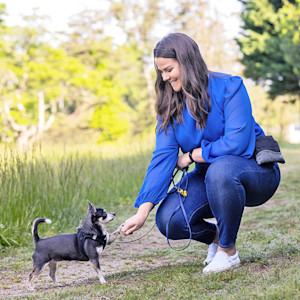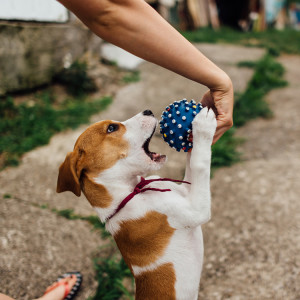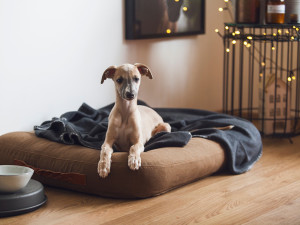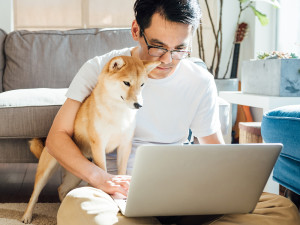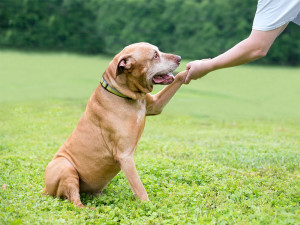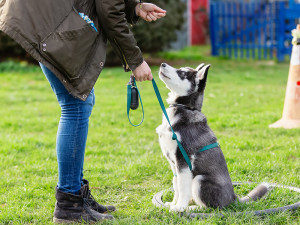Teach Your Dog to Lie Down in a Few Easy Steps
This is one of the most helpful cues you can ever teach your dog.
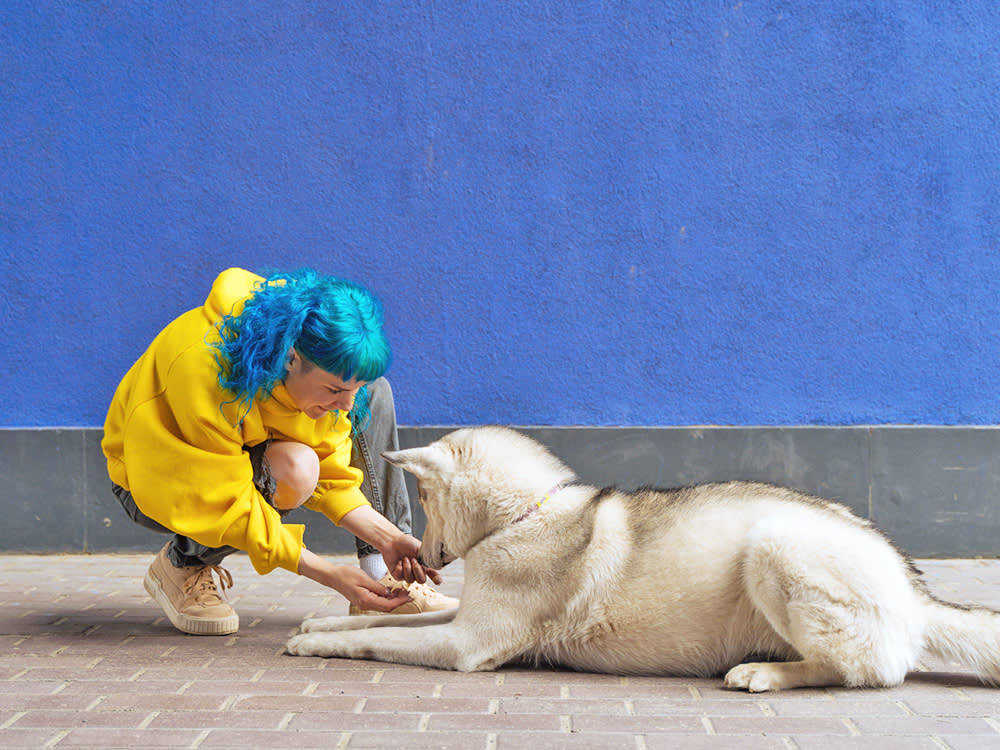
Share Article
In This Article:
Why ‘Lie Down’ Is an Important Cue Training Your Dog to Lie Down What to Do if Your Dog Won't Lie Down Common Training Mistakes How Long Will This Training Take?
Dogs naturally spend a lot of time lying down. They jump up eagerly for mealtimes and outings and anything else that interests them, but getting them to lie down on cue? Not so easy. Puppies especially benefit from being down to, well, calm down, stay out of trouble, and build impulse control. Fortunately, down can be one of the easier behaviors to train because dogs do it naturally.
Annie Grossman, founder of Manhattan’s School for the Dogs and author of the 2024 bookopens in new tab, How to Train Your Dog With Love and Science, advises using your dog’s natural behavior to your advantage. “Every dog lies down some of the time. So when you’re working on training new behaviors, you can be pretty sure this is one that they're going to engage in at some point, which opens the door to easy training,” she says. “[It’s] easier to train behaviors dogs regularly engage in on their own than to train them to do something totally novel.”
How much do you spend on your pet per year?

Why is lying down an important cue for dogs?
We value an effective “down” cue because it keeps our energetic pets in one spot. This can be helpful in public places and work environments. A well-trained “down” can also avert a dangerous situation, like a dog chasing a squirrel into the road (which my dog Willy tends to do). The more control you have, the more freedom your dog has.
“Down” is an essential cue like “sit,” “heel,” “come,” and “stay.” Once you’ve got it down, no pun intended, it’s fun to move on to other useful tricks and educational games.
Step-by-step guide to training your dog to lie down
Brett Reynolds, director of dog care at The Dog Stopopens in new tab, says all dogs lie down to rest, but not all know
“down” as a trained behavior. “The three main ways to teach new skills are,” he says, “luring with a treat or toy to guide the dog into position, capturing the behavior happening naturally and rewarding it, and shaping — which means reinforcing approximations of the behavior in small steps.”
1. Use a treat to lure them into lying down.
Grossman differentiates between capturing and luring. You can capture “down” by waiting for your dog to lie down on their own. Hide a handful of small treats in your palm, station yourself near a place your dog normally lies down, and wait. “Be boring. Once they [lie down], immediately mark the behavior with a clicker or a verbal marker like ‘yes,’” Grossman says. (A clicker is a small noisemaker with a short, metallic sound that aids in positive reinforcement training.) “I like to give the dog the treat just far enough in front of them or above them that they have to get up to get it, thereby resetting them to lie down again. The goal is to get many repetitions of this, so your dog understands that lying down on their own earns the click or ‘yes’ and the reward.”
Like training your dog to sit, luring is a reliable method. Luring them down involves using a treat to guide your dog into the down position. “Hold a treat in your hand, and move it from your dog’s nose down towards the floor and then horizontally away from them, creating a ‘2’ shape. Your dog’s nose should follow the treat, causing their body to slide down. As soon as their elbows touch the ground, mark and reward.” Dogs appreciate multiple cues. Once your dog is consistently following the hand motion, introduce a verbal cue or hand signal (see below).
2. Introduce a verbal cue.
Once your dog is reliably offering the down behavior using a treat five or six times in quick succession, begin to add a verbal “down” cue. “Say ‘down’ as your dog is in the process of lying down, then mark and reward. This pairs the word with the action,” Grossman says.
3. Introduce a hand signal.
A hand signal also reinforces the desired behavior. Grossman likes to hold her hand up, palm out, “like you’re taking an oath,” she explains. “Start to give the cue — the word or the visual cue — a bit earlier and earlier until your dog is reliably lying down after you give the cue, not while you are giving it,” she says.
4. Practice with your dog consistently.
Children don’t learn multiplication tables without repetition. In the same way, your dog needs to practice. Practice at home in short, regular sessions, then work up to more distracting places such as a dog park. Practice backing away before giving the cue. “Once the behavior is learned in one setting, practice it in different environments and with different people to help your dog understand it applies everywhere,” Grossman says.
Reynolds says consistency is key to the “down” cue. “Consistency helps build strong associations, strengthen muscle memory, and fosters trust and confidence,” he says. “Regular, predictable practice sessions help your dog know what to expect.”
What should you do if your dog doesn’t lie down?
Never force your dog into a position, Reynolds says. “If they aren’t comfortable lying down for you, there could be underlying trust issues, confusion, or even physical pain,” he says. Be aware of any places your dog is reluctant to lie down. “Since lying down is a vulnerable position, some dogs are selective about the position in some contexts,” Reynolds continues. “For example, your dog may feel safe and comfortable lying down on the couch with nobody around, but reluctant in situations where they are nervous or alert, like at a training class or the vet’s office.”
If the luring method isn’t working, Grossman suggests trying to sit on the ground and luring your dog under one bent leg (depending on their size). “Use the marker — a ‘yes’ or a click — as soon as their body hits the ground as they try to get under your leg,” she says.
If your dog is having focus issues, platform training (or stationing) establishes a specific place, like a mat or a low table with a non-slip surface, for your dog to get in the training mindset. The idea is to give them a chill, predictable place to focus. Another strategy for training energetic dogs is starting a session after a walk, when they’re tired.
Common mistakes and things to know when training your dog
Don’t make the common training mistake of misusing the “down” cue. If you’re teaching your dog to lie down on the ground or the floor, don’t use the same word to tell them to get off the couch or take their paws off the windowsill. Instead, use the word “off” or the cue “leave it.”
Recognize that training is tiring, especially for a puppy. Do you remember feeling tired when you came home from school? Training is a form of school for your dog, so make sure they get a chance to nap after a session. Break up training sessions with intervals of play training: This originated as a way to redirect aggressive dogs, but has an overall positive effect on learning and emotions. Think of it as recess for fidgety pups.
How long does it usually take for a dog to learn to lie down?
Unfortunately, there’s no precise answer. “Training timelines vary widely depending on techniques and preferences of the learner,” Reynolds says. “Healthy, pain-free dogs usually pick up the behavior within a few sessions, provided that the trainer is patient and meets the dog where they are.”
For some dogs, it could take a very long time to learn “down,” but remember, it’s never too late to teach an old dog new tricksopens in new tab. You can and should engage your senior dog in training sessions.
Bottom line
Training the “down” cue is one of the building blocks of training basics like the “sit,” “stay,” “come,” and “heel” cues.
Fortunately, it’s a natural behavior that you can use to your advantage in training.
Start training the “down” cue in a calm, quiet place at home with treats. Then introduce verbal cues and hand signals.
With regular, consistent training, your dog should soon be able to execute the “down” cue in a busy place like a park.
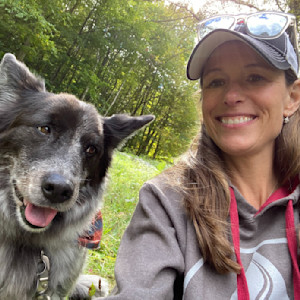
Catherine Fahy Green
Catherine Fahy Green is a journalist turned copy and content writer. As a pets writer, she focuses on and is fascinated by animal body language because there's so much to learn from and about animals by spending time in their presence and observing their physical cues.
Her work as a PR specialist appears in national trade media as press releases and stories about exciting new products people should try. She lives with her family in Western Massachusetts, where she listens closely to the stories her two dogs, flock of chickens, and four horses tell her. She spends her weekends at horse shows with her daughter.
Related articles
![A red haired woman dog trainer kneeling in front of a Shepherd mixed breed dog with one finger raised that the dog is looking at in an outdoor training course.]()
Understanding Popular Dog Training Methods
Look behind the advertising language when picking a dog trainer.
![Greyhound puppy sitting on her bed on the bedroom floor]()
Use Platform Dog Training to Elevate Your Pup’s Skills
Using platforms are favorites with pro dog trainers—here’s why you should add them to your training to-do list.
![A dark-haired man using a laptop to train his Shiba Inu online]()
How Online Training Supports Dog Owners and Dog Trainers
The virtual dog-training revolution is here.
![A senior Retriever/Terrier mixed breed dog shaking hands with its owner.]()
How to Teach an Old Dog New Tricks
Your senior dog might move slower these days, but that doesn’t mean they can’t learn new things.
![Boston terrier being stubborn]()
Dog Training — DIY or Hire a Pro?
When it’s time to call in reinforcements.
![Woman trains with a young husky on a dog training field]()
How to Find a Qualified Trainer for Your New Dog
The questions to ask and credentials to look out for to find the right trainer for your dog, according to a pro.

